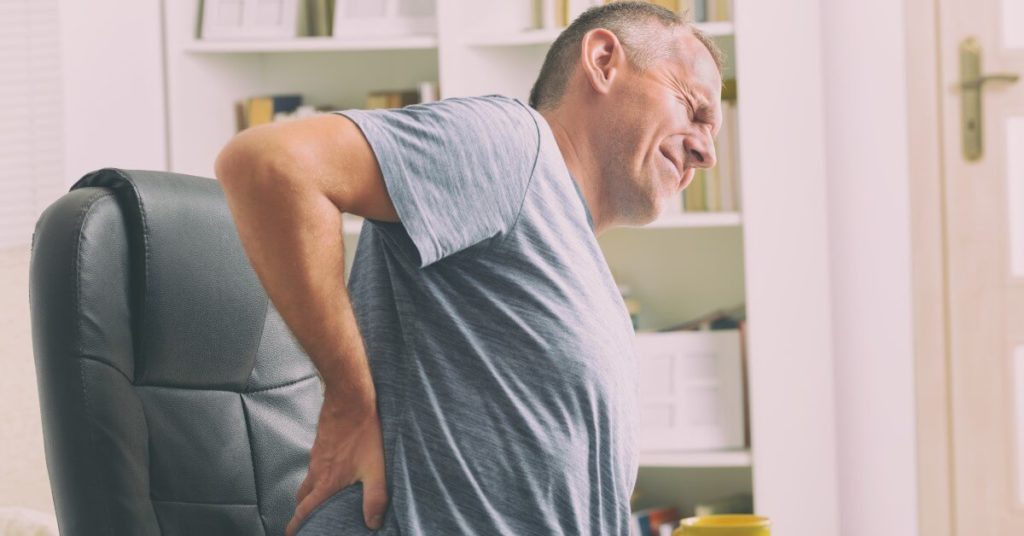
The Mechanics of the Back | Tips for a Healthier Back | What’s the Takeaway?
Overview
Back pain is no joke. It’s the leading cause of disability and absenteeism from the workplace worldwide,[1] and can be a chronic source of frustration for many people as they search for ways to feel better.
The most frustrating part of back pain is that, for the most part, it’s mechanical and not linked to anything immediately identifiable.[2] Although this means that most back pain is not considered serious, it can interfere with the quality of life. Effective treatment may be a matter of trying different approaches over time.
Keep reading as we discuss the mechanics of back pain and give you tips to help manage back pain.
The Mechanics of the Back
Back pain is a common issue. By some estimates, nearly a quarter of the world’s population is dealing with chronic low back pain.[2] It’s not entirely surprising, however, as the lower back supports the weight and movements of the upper body. Over time, it can start to wear. If issues like arthritis, injuries, or overuse occur, this can exacerbate the problem.
The potential for problems over time is likely. No wonder so many people have this condition in adulthood.
Tips for a Healthier Back
1. Posture
When you were a kid and were told to ‘sit up,’ it may have been annoying, but there are some compelling reasons why proper posture is a great habit to learn and maintain.
If you have a job where you are sitting for extended periods, keep your feet planted on the floor and have your computer screen in a place that allows you to see it comfortably without hunching over.
Keep your spine straight while sitting or even moving about or performing activities. When lifting, bend and straighten at the knees and not the waist/lower back. No slouching!
2. Bedtime Rules
We spend a significant amount of our lifetimes sleeping. It’s a natural way for the body and mind to recharge and restore fully. However, when chronic pain, such as back pain, is present, the bidirectional relationship between sleep and pain becomes more evident. Studies have shown that poor and insufficient sleep duration are risk factors for chronic pain[3] while chronic pain can cause poor sleep and duration.[4]
Sleeping on your side or back is preferred to sleeping on your stomach. Tucking a pillow between your legs to align your hips can also help keep the lower back aligned and rested.
Raise your sleep quality by maintaining a regular sleep-wake schedule (even on weekends or other non-work days). Avoid heavy or spicy food, alcohol, smoking, or stimulating electronics such as smartphones before bedtime. Sleep in a cool, dark room to maximize your sleep hygiene and give you the best chance at a great night’s rest that is refreshing and easy on the back.
3. Strengthen Your Core
Exercise has no equal in the world of health. Humans are made to move. In our relatively convenient world, it is easy to forget how exercise positively impacts every part of the human body. For back pain specifically, core exercises rule the day! Your core consists of your pelvis, lower back, hips, and stomach. Exercises that target this midsection, such as sit-ups, planks, and bridges, work to strengthen your core and provide more stability which takes a lot of work off the lower back.
Think you have to be a bodybuilder to reap the great benefits of exercise? Studies have shown that even moderate exercise can improve back pain.[5] Some basic lower back stretching exercises should also be included as these are great, drug-free ways to relieve back pain.
4. Keep Weight Under Control
Keeping a healthy weight is crucial to nearly all aspects of your health. Obesity drives hypertension, cardiovascular disease, and diabetes – to name just a few. If you have back pain issues, your body weight is even more critical in relief and prevention. Excess body weight adds to the stress on the spine, while metabolic syndrome (prevalent in many overweight/obese people) spurs chronic back pain, as does a wide waist circumference.[6] Aim to keep a healthy weight range for your height by eating healthy and exercising. See your doctor if you require further guidance on this.
5. Other Ways to Manage Pain
Due to back pain’s complex nature and often the elusive root cause, you may have tried some or all of the above suggestions to relieve back pain. What now?
There are still options. Although it should not be the first choice, over-the-counter (OTC) medications can help with back pain. OTC medications with anti-inflammatory properties, such as Ibuprofen, Naproxen, and Aspirin, help because they reduce any swelling that causes further pain due to pressure.[7] If there is still a lot of pain, speak to your doctor. Physiotherapy, massage therapy, cortisone injections, and surgery are options pending appropriate medical tests.
What’s the Takeaway?
Back pain is one of the most common reasons people seek care in both primary and emergency medicine settings.[2] Don’t be discouraged if you’re one of the millions who experience back pain, discomfort, and intrusion. There are many paths to relief, ranging from simple, mechanical approaches to surgery.
But before you opt for the higher end of that range of treatments, you are encouraged to try some of the lifestyle remedies above. Free of side effects, these can become part of your life, and focus on health no matter the immediate goal.
References:
- Ehrlich G. E. (2003). Back pain. The Journal of rheumatology. Supplement, 67, 26–31.
- Casiano, V. E., Sarwan, G., Dydyk, A. M., & Varacallo, M. (2023). Back Pain. In StatPearls. StatPearls Publishing.
- Afolalu, E. F., Ramlee, F., & Tang, N. K. Y. (2018). Effects of sleep changes on pain-related health outcomes in the general population: A systematic review of longitudinal studies with exploratory meta-analysis. Sleep medicine reviews, 39, 82–97. https://doi.org/10.1016/j.smrv.2017.08.001
- Kelly, G. A., Blake, C., Power, C. K., O’keeffe, D., & Fullen, B. M. (2011). The association between chronic low back pain and sleep: a systematic review. The Clinical journal of pain, 27(2), 169–181. https://doi.org/10.1097/AJP.0b013e3181f3bdd5
- Nilsen, T. I., Holtermann, A., & Mork, P. J. (2011). Physical exercise, body mass index, and risk of chronic pain in the low back and neck/shoulders: longitudinal data from the Nord-Trondelag Health Study. American journal of epidemiology, 174(3), 267–273. https://doi.org/10.1093/aje/kwr087
- Su, C. A., Kusin, D. J., Li, S. Q., Ahn, U. M., & Ahn, N. U. (2018). The Association Between Body Mass Index and the Prevalence, Severity, and Frequency of Low Back Pain: Data From the Osteoarthritis Initiative. Spine, 43(12), 848–852. https://doi.org/10.1097/BRS.0000000000002601


